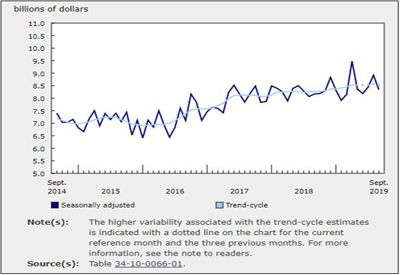Just Add Value

Dec 14 2015
Danah Head
Imagine this scenario: you walk into your warehouse, your financial vault. As you stand there you have no idea of the actual locations of anything or that the value of your entire workforce and their families depends on it. You are just an innocent person, standing in awe at the towering magnificence. The whole time you are there enjoying the view. You are not envisioning current dollar value, future value, or dead or dying stock. No one’s paycheque depends on the sales of it all. This is just cool stuff all over the place.
Maybe you would be staring at tiles, or gaskets, or in today’s economy an unimaginable pantheon of steel coil. In any event, the feeling would be so neat to just stand there blankly and enjoy every breathtaking moment of every box, stack, and bin of materials. All the workers are there around you bustling about happily, whistling some friendly tune in unison. You can even imagine going back to your desk and colouring the day away with a brand new box of crayons and getting paid for it. Sigh.
That was fun
Unfortunately, this is not how it really is for anyone with any experience in the supply chain universe. Sometimes when you walk in your warehouse, you immediately step into unbridled fear, uncertainty and trepidation. Maybe when you walk out there you are disappointed and saddened because no one seems to care as deeply as you do about the stacks and bins and boxes of your company’s inventory/money. This is not just a job for you; this is your life, your bread and butter, your reason for getting out of your bunny slippers and leaving half a cup coffee on the bathroom sink every day, fighting traffic, and paying off mountains of student debt. This, my friend, is passion.
Value
Some people reading this article will probably never get the joy of walking into a warehouse blind as I previously described. However many of the people working in the warehouse, around the warehouse, and selling your inventory ona golf course somewhere do. Every day, they get out of their bunny slippers full of a different motivation, money, family, obligation, habit… who knows. The idea is to align their motivation with your company’s and protect your inventory from unnecessary loss.
Change
As I grew in my career and education, I found myself standing in a big, grown-up, corporate inventory filled warehouse. I also found that not everyone around me shared my deep passion for keeping inventory safe. Not everyone thought it was completely amazing when a cycle count came out 100% on target. I was stunned to find that properly storing, packing, counting, and shipping our product was an irritation to most of the warehouse employees. So I went on a mission. The mission was to instill the idea of value into the people who are responsible for my employer’s inventory. My goal was to begin by proving to the warehouse team the real value of our inventory. We could come together and be even more successful than I could fathom possible on my own.
When this all began, most of the people who were bunny-slipper-less and working the warehouse were mad, angry, disappointed, or just overwhelmed and unmotivated. I kept asking myself why this was happening. Why are the people who are touching, counting, shipping, moving, displaying this beautiful thing, this inventory, this money that pays all of our paycheques, why are they so grumpy? The answer was a little difficult to find because everyone before me had gotten muddled in the symptoms of the issues, not the actual issue. I bet even you reading this now said the word in your head as you read this, and said it in a very Jerry Seinfeld to Newman way: management.
Education
The answer was not necessarily management, it was an utter lack of understanding by the people who were hired to protect the inventory. They did not understand their roles. The worst part is these were the people behind the big semi-truck size doors, toiling in the heat, the dust, the grime, and boxes, shipping tape, and time crunches. Each with nearly 10 or more years of service to the company. They were tasked with daily goals but did not even realize the reason why. When asked, they would say in one way or another that their role was to fill their personal bank accounts and a hole in the company roster.
What boggled me was that these people cycle counted like expert mathematicians, whizzed up ladders, had a virtual 3D map in their brains of every bolt, plug, gasket, and insert we owned, and recalled each one with amazing precision. However, they still didn’t get the point. Most people faced with this problem would be back to pointing the finger at management and say, “if only the employees were paid more,” or “If only the employees were treated better.” Easy band -aid answer, yes; issue solver, no.
Moving forward
Change came from investment, not in more inventory, but by investment in the people who worked out there in the concrete and steel forklift driven sweaty world that is a warehouse. I started by making sure each person was told about their role. The question for them was: how was their “job” one of the most important in the company? Each person was a face of the company. Every time a package goes out with our dollars/inventory safely tucked inside, contents correctly counted all represented their personal value. As time progressed, the warehouse employees bought what I was selling, which was the truth. Leading from a non-management role by example and banging the drum of personal individual value, each one became more than a manual labourer.
These people grew individually into key players in the grand cycle of inventory life. Positive, even tactile change, simply happened. The dust lessened, loss lessened, accountability set in naturally, problem solving and solution finding became the norm. None of that happened because management changed, and definitely not because I told them to, or because a paycheque was consistently cut. This happened because each person was given the chance to understand fully how important their role was to the inventory and thus to the company as a whole.
At the end of the day when these employees get out of their bunny slippers now, they know that they are the protectors of the bottom line. They are not just forklift drivers, they are sales men and women by making sure the customer has a good experience when they open their boxes or pallets, thus having return business. They are protectors of the cycle count, and they can and will want to dig deeper for answers to why cycle count is off. They watch the engineers sign out their requisitions.
Find out what your warehouse staff really think. Ask your people what they think they do every day. Question them about why do they drive to work every day. Then ask yourself what you wish they thought and figure out how you can instill your passion into them. I am happy to answer any questions you may have concerning your inventory dreams and how to help them come true. (Disclaimer: singing employees not a guarantee but we can try!)
Danah Head is an Executive Advisor for The Distribution Team. Danah has earned both her MBA in Technology Management for Supply Chain and MAED in Adult Education and Corporate Training. While pursuing her education, she worked in different purchasing and supply chain roles within the manufacturing industry. She has real world experience and technical training to help find the best solutions for warehouse and distribution companies. For more information, call (918) 992-5022 in Tulsa, Oklahoma or e-mail Danah@Distributionteam.com. Also be sure to visit The Distribution Team online www.thedistributionteam.com.
More from Danah Head in CEW…
Loss, Theft, Damage… What is the Cost?
Customers = Profitability… Right?
May Flowers Start with April Showers











